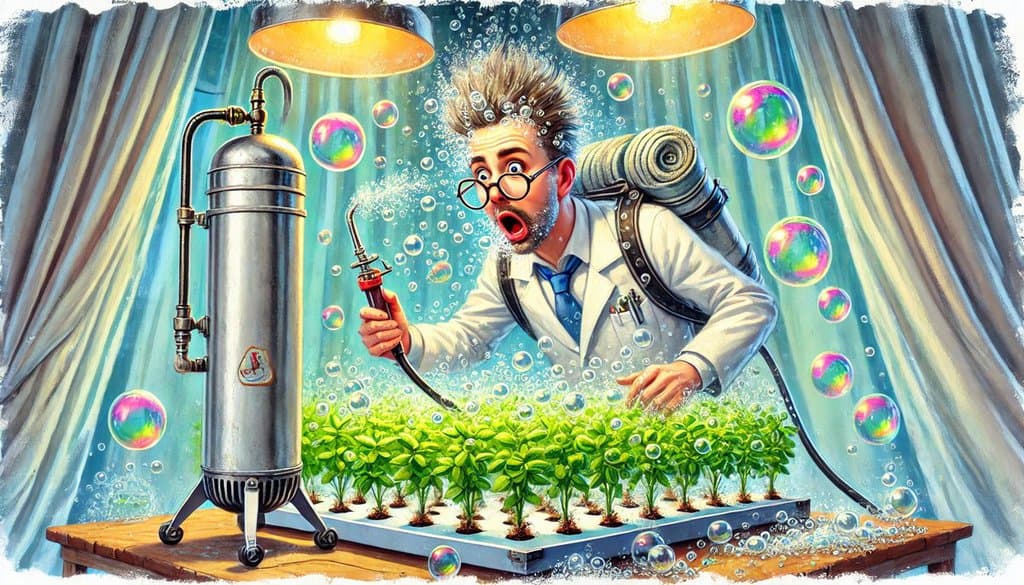Proper aeration in your hydroponic system is crucial for optimal plant growth and health. Here are some key methods and considerations for achieving proper aeration.
Aeration Techniques
Air Pumps and Air Stones
One of the most common and effective methods for aerating a hydroponic system is using air pumps connected to air stones. These devices create bubbles in the nutrient solution, increasing dissolved oxygen levels[1]. Air pumps should be run continuously (24 hours a day) to maintain consistent oxygenation[2].
Larger systems would use an air blower/ring blower; These are noisy but very effective and very long lasting compared to diaphragm air pumps.
Venturi effect: If you have a water pump and add an air intake on the outflow, it pulls air into the water flow, thereby oxygenating the water. This system can make some noise from the air inlet but works very nicely.
Vortex Oxygenators
Vortex oxygenators can be used in combination with air pumps to enhance oxygenation. These devices create a swirling motion in the nutrient solution, increasing the surface area for gas exchange[2].
Hydrogen Peroxide Application
Periodic application of hydrogen peroxide can boost oxygen levels in the nutrient solution. High-frequency application (every third day) of hydrogen peroxide, combined with vortex oxygenation and air pump injection, has been shown to yield the highest chlorophyll production in plants[2].
Water spray bar: If you have a powerful water pump and don’t use all the pressure, surface mount a pipe that either sprays directly down into the water or plug the end and drill some holes on a line. These holes will then spray water evenly on the water surface and pull air down into the water, thereby aerating your water. Both solutions do make some noise and splash water drops around if no guard is in place.
Workshop Air compressor, NO! Don’t think that thought, please. There are plenty of reasons why you should not use this type of compressor, but this is maybe the most important one: Any oil-filled compressor will, over time, release oil smog into the compressed air, which will end up in your system.
Benefits of Proper Aeration
Adequate aeration in hydroponic systems offers several advantages:
- Improved plant growth and vigor
- Enhanced nutrient uptake
- Increased water absorption by roots
- Higher chlorophyll content in leaves[2]
Monitoring and Maintenance
Dissolved Oxygen Levels
Regularly monitor dissolved oxygen levels in your nutrient solution to ensure they remain optimal for plant growth. While specific requirements may vary by crop, maintaining adequate oxygen levels is crucial for root health and nutrient absorption[4]. If you use an air pump and airstones, check if they work as they should and replace or rinse the stones as needed. PRO TIP: While nothing should die within an hour of pump failure, its always nice to have a backup pump(and air stones) available and ready.
Root Health
Inspect plant roots periodically for signs of stress or damage. Healthy, well-aerated roots should be white and robust. Brown or slimy roots may indicate insufficient oxygenation[1].
Considerations for Different Hydroponic Systems
Deep Water Culture (DWC)
In DWC systems, where plant roots are constantly submerged, proper aeration is particularly critical. Ensure that air stones or diffusers are evenly distributed throughout the nutrient reservoir[2].
Nutrient Film Technique (NFT)
While NFT systems naturally provide some aeration as the nutrient solution flows over the roots, additional oxygenation through air pumps can still be beneficial, especially in warmer climates or for oxygen-demanding crops[5].
Floating Systems
In floating hydroponic systems, where plants are supported on a floating platform, aeration of the nutrient solution has been shown to promote plant growth, enhance nutrient uptake, and increase water absorption[3].
Implementing aeration ensures that your plant roots receive the oxygen they need for healthy growth and optimal results.
External sources:
[1] https://www.semanticscholar.org/paper/25addfa406d9b7f07b98ca466c2e1ae33b7552da
[2] https://www.semanticscholar.org/paper/29c9003dfcba0bd013be562a5a18457c6e63ec20
[3] https://www.semanticscholar.org/paper/799723f01810e0488d5f14118efe2e1789c03202
[4] https://www.semanticscholar.org/paper/af6d0950bc2c578db74301c62dc53a5ea26585c7
[5] https://www.semanticscholar.org/paper/7ccf606e1de5978fe01c404be85594f63395a7dd

